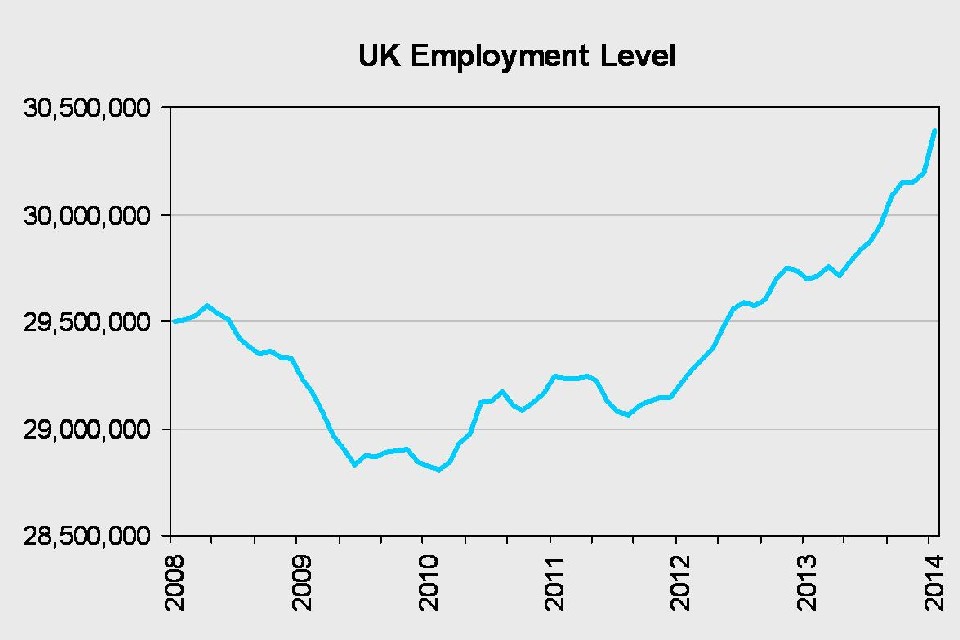Unemployment drops below 7%
Unemployment has dropped below 7% for the first time since the recession and employment has seen the biggest annual jump in a generation.

Unemployment has dropped below 7% for the first time since the recession and employment has seen the biggest annual jump in a generation, figures published by the Office for National Statistics today (16 April 2014) show.
Unemployment fell by 77,000 in the last 3 months, taking the unemployment rate to 6.9% for the first time since 2009.
In the largest annual rise in nearly 25 years, the number of people of people in a job rose by 691,000 – more than double the population of Newcastle – bringing the record number of people in work to 30.39 million.
Wages also rose on the year by 1.7%, against yesterday’s announcement that March’s inflation had dropped to 1.6%, and job vacancies rose again, up 108,000 over the past year bringing the number of vacancies in the UK economy to 611,000.
Minister for Employment Esther McVey said:
More young people are in work, more women are in work, wages are going up, and more and more businesses are hiring – and it’s a credit to them that Britain is working again.
But there is still more to do – which is why I’d go even further and call on more employers to work with us to tap into the talent pool the UK offers.

The number of people in work has increased by 1.5 million since 2010 – over a million of these jobs are full-time – and the employment rate is now 72.6%, showing the government’s long-term economic plan to back enterprise and businesses so they can create jobs is working.
The proportion of women in work also hit a new record of 67.6% – the highest since records began.
Long-term unemployment is down 93,000 on the year, which is the largest annual fall since 1998. The number of unemployed young people also fell, by 38,000 over the last 3 months, and has been falling now for the last 7 months.
The number of people claiming Jobseeker’s Allowance (JSA) fell by 30,400 last month and is down 386,100 on the year. The number of young people claiming JSA has been falling for the last 22 months.
Today Employment Minister Esther McVey is visiting the north east, where employment is increasing and unemployment is falling. She will be seeing first hand government schemes in action, such as the event training scheme that produced Jesse J’s make-up artist, and Jamie’s Italian restaurant in Newcastle, which are helping young people increase their skills and find jobs.
Background to labour market statistics: April 2014
This month’s Labour Force Survey covers December 2013 to February 2014. The claimant count is for March 2014 and the vacancy count for January 2014 to March 2014.
The number of people in work rose this quarter
- 30.39 million people were in work in December 2013 to February 2014
- the employment level rose 239,000 on the previous quarter and 691,000 on the year
- the employment rate is 72.6%, up 0.5 points on the quarter and up 1.2 points on the year
ILO unemployment fell this quarter
- 2.24 million people were ILO unemployed in December 2013 to February 2014, down 77,000 on the previous quarter and 320,000 on the year
- the ILO unemployment rate is 6.9%, down 0.3 points on the quarter and down 1.1 points on the year
The level of economic inactivity is down on the quarter and on the year
- the economic inactivity level is 8.85 million in the December 2013 to February 2014 quarter, down 86,000 on the previous quarter and 104,000 on the year
- the economic inactivity rate is 21.9%, down 0.2 points on the quarter and down 0.3 points on the year
- excluding students, inactivity as a share of the 16-64 population is 16.4%, down 0.1 points on the quarter and down 0.3 points on the year
The number of people claiming one of the main out-of-work benefits is falling
- claimant unemployment was 1.14 million in March 2014, down 30,400 on the month and down 386,100 on the year
- the claimant count rate is 3.4%, down 0.1 points on the month and down 1.2 points on the year
- in the year to August 2013, the number claiming incapacity benefits fell 76,200 to 2.44 million – the most recent provisional figure for February 2013 suggests the caseload has risen slightly since then
- in the year to August 2013, the number of lone parents on income support fell 47,700 to 498,000 – the provisional figure for February 2013 is 480,000
The number of redundancies rose and unfilled vacancies rose on the quarter
- there were 117,000 redundancies in December 2013 to February 2014, up 5,000 on the previous quarter but down 20,000 on the year
- ONS’ vacancy survey estimates an average of 611,000 unfilled vacancies in the 3 months to March 2014, up 38,000 on the previous quarter and 108,000 on the year
Total weekly pay in December to February 2014 was up by 1.7% over the year
- growth in regular weekly pay, excluding bonuses, was up by 1.4% on the year
More information
Read the Universal Credit experimental statistics, also out today.
Contact Press Office
Media enquiries for this press release – 020 3267 5161
Press Office
Caxton House
Tothill Street
London
SW1H 9NA
London Press Office (national media and London area enquiries only – not questions about personal claims) 020 3267 5144
Out-of-hours (journalists only) 07623 928 975
England and Wales (local media enquiries) 029 20 586 then 097 or 098 or 099
Scotland (local media enquiries) 0131 310 1122
Follow DWP on:
- Twitter – www.twitter.com/dwppressoffice
- Facebook – www.facebook.com/dwp
- LinkedIn – www.linkedin.com/company/dwp
- YouTube – www.youtube.com/dwp